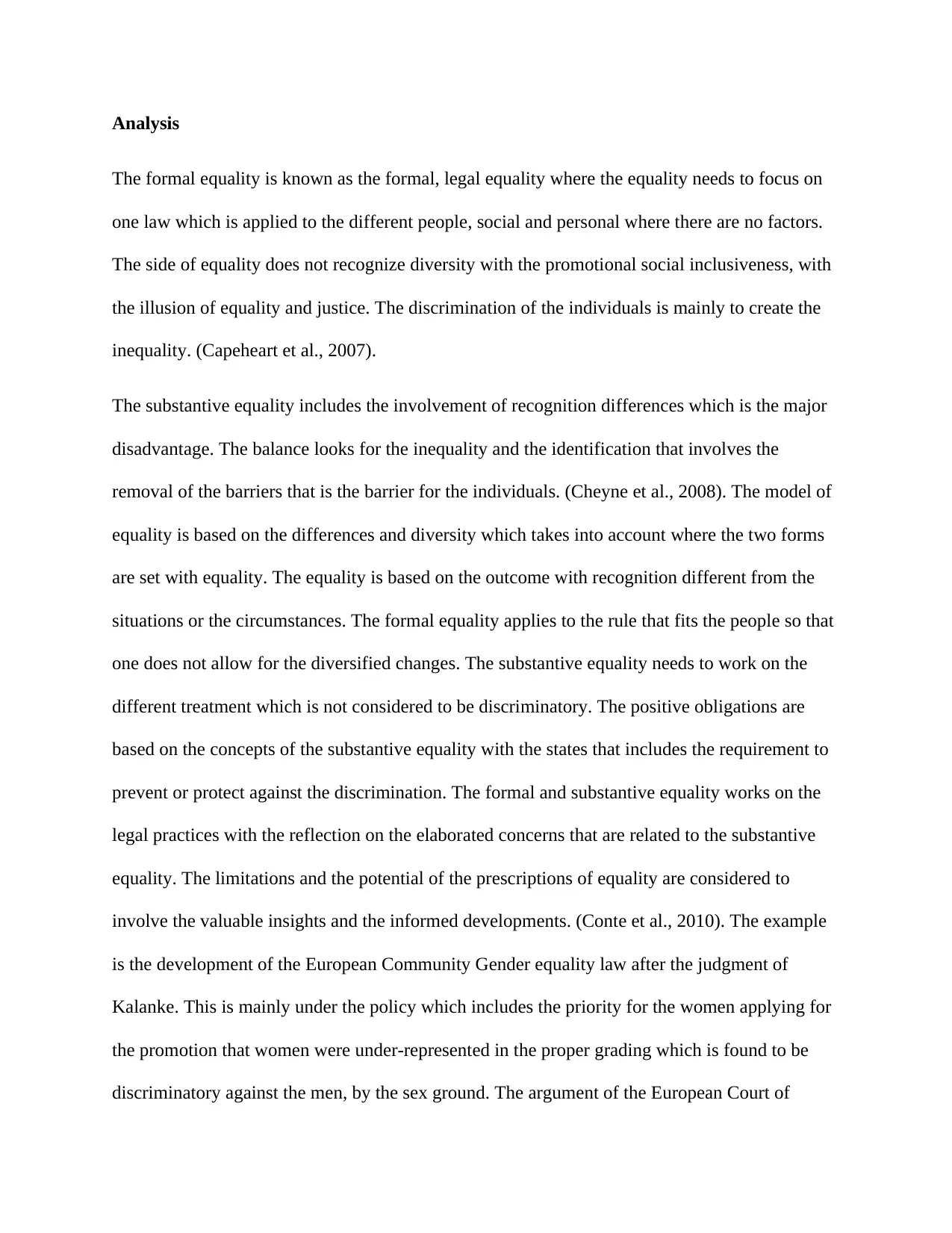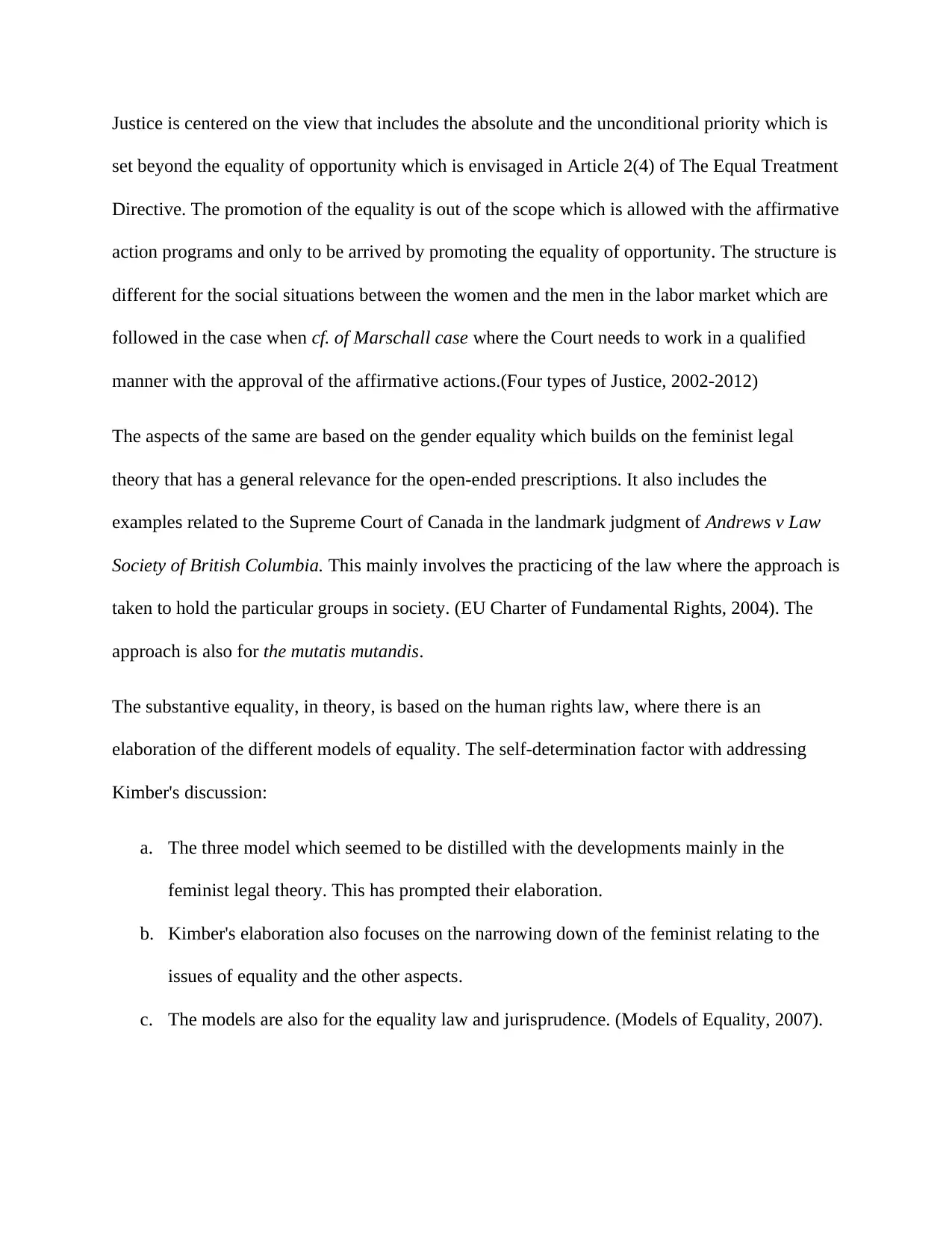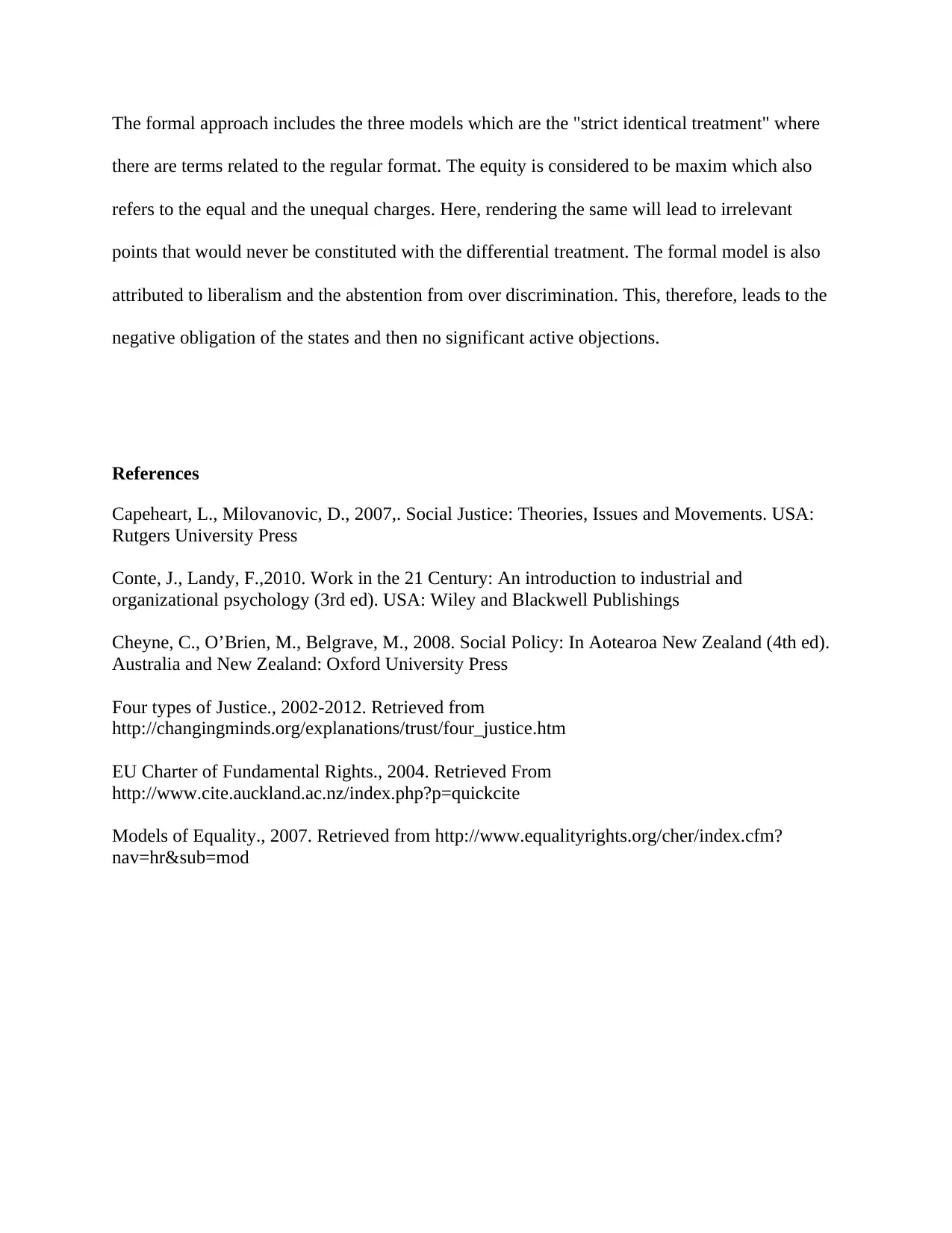Formal vs. Substantive Equality Report
VerifiedAdded on 2019/11/19
|4
|908
|192
Report
AI Summary
This report delves into the concepts of formal and substantive equality, highlighting their differences and implications. Formal equality emphasizes identical treatment under the law, regardless of individual circumstances, while substantive equality acknowledges and addresses existing inequalities to achieve equitable outcomes. The report uses examples from European and Canadian case law, such as the Kalanke and Andrews cases, to illustrate the practical application of these concepts. It also discusses the role of feminist legal theory in shaping the understanding of substantive equality and explores different models of equality, including the 'strict identical treatment' model and models that account for differences and diversity. The report concludes by emphasizing the importance of considering both formal and substantive equality to achieve true justice and social inclusiveness.

report
Paraphrase This Document
Need a fresh take? Get an instant paraphrase of this document with our AI Paraphraser

Analysis
The formal equality is known as the formal, legal equality where the equality needs to focus on
one law which is applied to the different people, social and personal where there are no factors.
The side of equality does not recognize diversity with the promotional social inclusiveness, with
the illusion of equality and justice. The discrimination of the individuals is mainly to create the
inequality. (Capeheart et al., 2007).
The substantive equality includes the involvement of recognition differences which is the major
disadvantage. The balance looks for the inequality and the identification that involves the
removal of the barriers that is the barrier for the individuals. (Cheyne et al., 2008). The model of
equality is based on the differences and diversity which takes into account where the two forms
are set with equality. The equality is based on the outcome with recognition different from the
situations or the circumstances. The formal equality applies to the rule that fits the people so that
one does not allow for the diversified changes. The substantive equality needs to work on the
different treatment which is not considered to be discriminatory. The positive obligations are
based on the concepts of the substantive equality with the states that includes the requirement to
prevent or protect against the discrimination. The formal and substantive equality works on the
legal practices with the reflection on the elaborated concerns that are related to the substantive
equality. The limitations and the potential of the prescriptions of equality are considered to
involve the valuable insights and the informed developments. (Conte et al., 2010). The example
is the development of the European Community Gender equality law after the judgment of
Kalanke. This is mainly under the policy which includes the priority for the women applying for
the promotion that women were under-represented in the proper grading which is found to be
discriminatory against the men, by the sex ground. The argument of the European Court of
The formal equality is known as the formal, legal equality where the equality needs to focus on
one law which is applied to the different people, social and personal where there are no factors.
The side of equality does not recognize diversity with the promotional social inclusiveness, with
the illusion of equality and justice. The discrimination of the individuals is mainly to create the
inequality. (Capeheart et al., 2007).
The substantive equality includes the involvement of recognition differences which is the major
disadvantage. The balance looks for the inequality and the identification that involves the
removal of the barriers that is the barrier for the individuals. (Cheyne et al., 2008). The model of
equality is based on the differences and diversity which takes into account where the two forms
are set with equality. The equality is based on the outcome with recognition different from the
situations or the circumstances. The formal equality applies to the rule that fits the people so that
one does not allow for the diversified changes. The substantive equality needs to work on the
different treatment which is not considered to be discriminatory. The positive obligations are
based on the concepts of the substantive equality with the states that includes the requirement to
prevent or protect against the discrimination. The formal and substantive equality works on the
legal practices with the reflection on the elaborated concerns that are related to the substantive
equality. The limitations and the potential of the prescriptions of equality are considered to
involve the valuable insights and the informed developments. (Conte et al., 2010). The example
is the development of the European Community Gender equality law after the judgment of
Kalanke. This is mainly under the policy which includes the priority for the women applying for
the promotion that women were under-represented in the proper grading which is found to be
discriminatory against the men, by the sex ground. The argument of the European Court of

Justice is centered on the view that includes the absolute and the unconditional priority which is
set beyond the equality of opportunity which is envisaged in Article 2(4) of The Equal Treatment
Directive. The promotion of the equality is out of the scope which is allowed with the affirmative
action programs and only to be arrived by promoting the equality of opportunity. The structure is
different for the social situations between the women and the men in the labor market which are
followed in the case when cf. of Marschall case where the Court needs to work in a qualified
manner with the approval of the affirmative actions.(Four types of Justice, 2002-2012)
The aspects of the same are based on the gender equality which builds on the feminist legal
theory that has a general relevance for the open-ended prescriptions. It also includes the
examples related to the Supreme Court of Canada in the landmark judgment of Andrews v Law
Society of British Columbia. This mainly involves the practicing of the law where the approach is
taken to hold the particular groups in society. (EU Charter of Fundamental Rights, 2004). The
approach is also for the mutatis mutandis.
The substantive equality, in theory, is based on the human rights law, where there is an
elaboration of the different models of equality. The self-determination factor with addressing
Kimber's discussion:
a. The three model which seemed to be distilled with the developments mainly in the
feminist legal theory. This has prompted their elaboration.
b. Kimber's elaboration also focuses on the narrowing down of the feminist relating to the
issues of equality and the other aspects.
c. The models are also for the equality law and jurisprudence. (Models of Equality, 2007).
set beyond the equality of opportunity which is envisaged in Article 2(4) of The Equal Treatment
Directive. The promotion of the equality is out of the scope which is allowed with the affirmative
action programs and only to be arrived by promoting the equality of opportunity. The structure is
different for the social situations between the women and the men in the labor market which are
followed in the case when cf. of Marschall case where the Court needs to work in a qualified
manner with the approval of the affirmative actions.(Four types of Justice, 2002-2012)
The aspects of the same are based on the gender equality which builds on the feminist legal
theory that has a general relevance for the open-ended prescriptions. It also includes the
examples related to the Supreme Court of Canada in the landmark judgment of Andrews v Law
Society of British Columbia. This mainly involves the practicing of the law where the approach is
taken to hold the particular groups in society. (EU Charter of Fundamental Rights, 2004). The
approach is also for the mutatis mutandis.
The substantive equality, in theory, is based on the human rights law, where there is an
elaboration of the different models of equality. The self-determination factor with addressing
Kimber's discussion:
a. The three model which seemed to be distilled with the developments mainly in the
feminist legal theory. This has prompted their elaboration.
b. Kimber's elaboration also focuses on the narrowing down of the feminist relating to the
issues of equality and the other aspects.
c. The models are also for the equality law and jurisprudence. (Models of Equality, 2007).
⊘ This is a preview!⊘
Do you want full access?
Subscribe today to unlock all pages.

Trusted by 1+ million students worldwide

The formal approach includes the three models which are the "strict identical treatment" where
there are terms related to the regular format. The equity is considered to be maxim which also
refers to the equal and the unequal charges. Here, rendering the same will lead to irrelevant
points that would never be constituted with the differential treatment. The formal model is also
attributed to liberalism and the abstention from over discrimination. This, therefore, leads to the
negative obligation of the states and then no significant active objections.
References
Capeheart, L., Milovanovic, D., 2007,. Social Justice: Theories, Issues and Movements. USA:
Rutgers University Press
Conte, J., Landy, F.,2010. Work in the 21 Century: An introduction to industrial and
organizational psychology (3rd ed). USA: Wiley and Blackwell Publishings
Cheyne, C., O’Brien, M., Belgrave, M., 2008. Social Policy: In Aotearoa New Zealand (4th ed).
Australia and New Zealand: Oxford University Press
Four types of Justice., 2002-2012. Retrieved from
http://changingminds.org/explanations/trust/four_justice.htm
EU Charter of Fundamental Rights., 2004. Retrieved From
http://www.cite.auckland.ac.nz/index.php?p=quickcite
Models of Equality., 2007. Retrieved from http://www.equalityrights.org/cher/index.cfm?
nav=hr&sub=mod
there are terms related to the regular format. The equity is considered to be maxim which also
refers to the equal and the unequal charges. Here, rendering the same will lead to irrelevant
points that would never be constituted with the differential treatment. The formal model is also
attributed to liberalism and the abstention from over discrimination. This, therefore, leads to the
negative obligation of the states and then no significant active objections.
References
Capeheart, L., Milovanovic, D., 2007,. Social Justice: Theories, Issues and Movements. USA:
Rutgers University Press
Conte, J., Landy, F.,2010. Work in the 21 Century: An introduction to industrial and
organizational psychology (3rd ed). USA: Wiley and Blackwell Publishings
Cheyne, C., O’Brien, M., Belgrave, M., 2008. Social Policy: In Aotearoa New Zealand (4th ed).
Australia and New Zealand: Oxford University Press
Four types of Justice., 2002-2012. Retrieved from
http://changingminds.org/explanations/trust/four_justice.htm
EU Charter of Fundamental Rights., 2004. Retrieved From
http://www.cite.auckland.ac.nz/index.php?p=quickcite
Models of Equality., 2007. Retrieved from http://www.equalityrights.org/cher/index.cfm?
nav=hr&sub=mod
1 out of 4
Related Documents
Your All-in-One AI-Powered Toolkit for Academic Success.
+13062052269
info@desklib.com
Available 24*7 on WhatsApp / Email
![[object Object]](/_next/static/media/star-bottom.7253800d.svg)
Unlock your academic potential
Copyright © 2020–2025 A2Z Services. All Rights Reserved. Developed and managed by ZUCOL.





